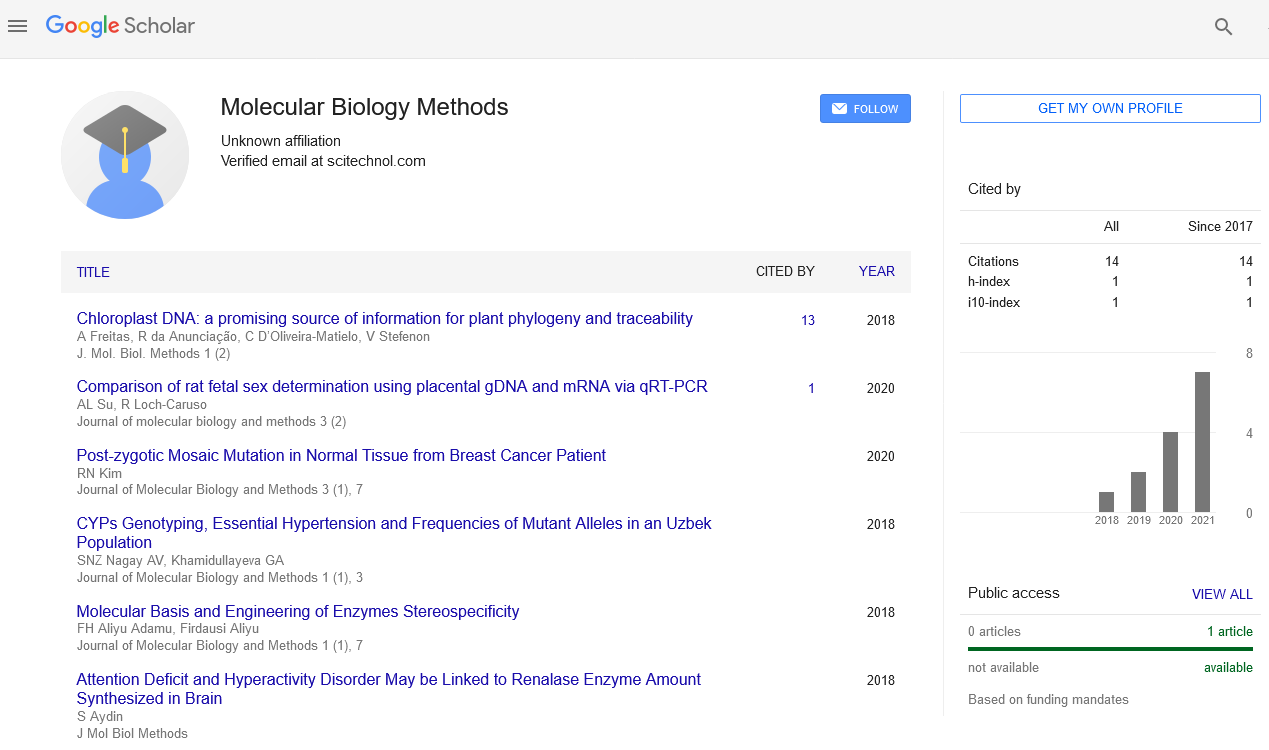Commentary, J Mol Biol Methods Vol: 4 Issue: 4
Tumor Biology is an Every Other Month Peer-Looked into Open Access Clinical Diary Covering Clinical and Trial Oncology
Galyna Khrushch*
Department of Plastic Surgery, Peoples Friendship University of Russia, Moscow
*Corresponding author: Galyna Khrushch, Department of Plastic Surgery, Peoples Friendship University of Russia, Moscow, Russia, E-mail: khrushuh.ga@uor Received date: July 06, 2021; Accepted date: July 21, 2021; Published date: July 28, 2021
Keywords: Apoptosis, Biochemistry, Bioinformatics
Introduction
Tumor Biology is an every other month peer-looked into open access clinical diary covering clinical and trial oncology. It was set up in 1980 as Oncodevelopmental Biology and Medicine, acquiring its present name in 1984. It is possessed by the International Society of Oncology and Biomarkers, of which it is the authority journal. Originally distributed by Karrer Publishers, it moved to Springer Science Business Media starting in 2010. In December 2016, the diary moved once more, this opportunity to SAGE Publications.The proofreader in-boss is Magdalena Chechlinska Curie Institute, Warsaw. As indicated by the Journal Citation Reports, the diary has a 2016 effect factor of 3.650. Tumor Biology's establishing editorial manager in-boss was William H. Fishman La Jolla Cancer Research Foundation, who altered the diary alongside Hide Matsu Hirai Hokkaido University from 1980 to 1983. In 1984, A. Munro Neville Ludwig Institute for Cancer Research took over as editorial manager in-boss, and in 1995, he was supplanted by Sabine von Kleist Albert Ludwigs University of Freiburg. In 1999, von Kleist resigned, so, all things considered she was supplanted by Thorny Stigbrand, who was as yet the diary's supervisor as of May 2017.In May 2017, Science Insider revealed that different researchers recorded on the diary's site as being individuals from its publication board had no connection with the diary. One researcher, German Nobel laureate Harald zur Hausen, disclosed to Science Insider that he didn't realize he was on the rundown, and that he didn't remember having at any point explored a paper for the journal. Understanding the unpredictable transaction between tumor cells and their encompassing non-threatening cells is opening up new ways to deal with creative disease medicines. The Tumor Biology and Microenvironment Program at Columbia's Herbert Irving Comprehensive Cancer Center (HICCC) plans to comprehend the immunological, stromal, and cell-inborn systems that control tumors inception and disease movement fully intent on making an interpretation of logical exploration discoveries to the facility. In 2019, the gathering got $27M in direct malignancy research subsidizing from the National Cancer Institute and National Institutes of Health in 2017. Their numerous continuous investigations incorporate assessment of how neural flagging drives gastric and pancreas tumorigenesis, and a co-clinical preliminary to test the capacity of bladder tumor or ganoids to anticipate patient reaction to chemotherapy. The program likewise means to build comprehension of malignancy immunology, distinguish novel immunotherapy approaches, and advance a space of disease research that is quickly developing and loaded with guarantee. Current activities in this space incorporate improvement of little atom c-Reel inhibitor to target administrative T cells in the tumor microenvironment, and a novel neoadjuvant immunotherapy preliminary to comprehend treatment reaction in patients. With the coming of high-throughput sequencing, our capacity to distinguish single nucleotide variations in the genome or exome of people has far surpassed our ability to tentatively approve their effect on sickness aggregates. Consequently, computational strategies that anticipate the effect of non-interchangeable SNVs on protein work have gotten vital and of wide premium. Bioinformatics strategies have been created and tried over the previous decade that recognizes sickness related nsSNVs from nonpartisan polymorphisms. An alternate, albeit related, issue is evaluating the significance of no synonymous physical variations in malignant growth development. On a fundamental level, useful physical transformations must be causative of malignant growth in the event that they influence disease driver qualities, which upon change give a particular specific benefit or a recently procured ability to the cell. The requirement for computational techniques to foresee the practical effect of malignant growth causing physical variations appears differently in relation to the low number of strategies that have been planned or tried explicitly for this reason. One likely clarification is the shortfall of curated sets of genuine driver and traveler disease transformations. Many as of late distributed malignant growth sequencing projects use techniques like SIFT, and PolyPhen2 to foresee the practical effect of disease physical transformations, albeit these strategies were not created or tried for this reason and the nature of their presentation in this setting isn't clear.
 Spanish
Spanish  Chinese
Chinese  Russian
Russian  German
German  French
French  Japanese
Japanese  Portuguese
Portuguese  Hindi
Hindi 